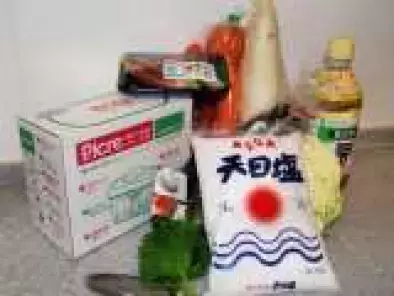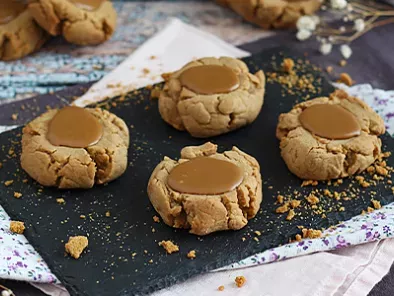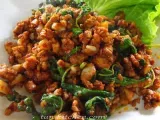Making Japanese Pickles the Washoku Way

I am excited to bring you this guest post by Shane Sakata who writes about Japan Travel and Culture at The Nihon Sun. Shane is on her second stint living in Japan. She loves the culture, the lifestyle and especially the food!
I recently had the pleasure of attending Ms. Andoh's "In a Pickle" workshop in the Tokyo kitchen of Taste of Culture and learned the ins and outs of making tsukemono from the foremost English speaking expert on Japanese cooking and food. It was a heady and inspiring day that prompted me to head out on a shopping spree for my very own pickle pot (shokutaku tsukemono ki) and some ingredients to see if it really was as simple as Ms, Andoh enthusiastically proclaimed. It is, and deliciously so!
First and foremost, I needed to raid my vegetable drawer and supplement what I had on hand with a trip to the grocery store in Chiba, Japan where I live. Vegetables are easy to procure, and so was the pickle pot but I really needed to put my limited Japanese language abilities to the test to find the ara jio (coarse seat salt) and some of the other pre-packaged ingredients.
The end result were the ingredients and apparatus needed to create Sokuseke-Zuke (Impatient Pickles), today's subject, and a variety of amazu (brine based sweet & sour) tsukemono.
Sokuseke-Zuke can be made with pretty much any vegetable that you have on hand but I chose the classic Japanese combination suggested by Ms. Andoh which includes cabbage, cucumber, myoga (if you can't find myoga substitute fresh ginger) and a small optional piece of kombu (a form of seaweed used in the process of making dashi or stock). During the "In a Pickle" workshop a combination of cabbage, carrot, daikon (Japanese radish) and myoga was used to create an equally tasty pickled salad.
 Now that you have chosen your vegetables, chop them into uniform paper-thin shreds and lightly toss with the ara jio - just enough so the vegetables start to sweat (about 1.5 teaspoons to 1/4 head of cabbage plus your other ingredients). Lightly toss the salt with your freshly chopped ingredients and allow to rest for a few minutes. The extraction of the brining liquid itself from the vegetables is done by a procedure called shio momi (salt rubbing or massaging), it starts with a light touch and proceeds to some very firm squeezing of the vegetables.
Now that you have chosen your vegetables, chop them into uniform paper-thin shreds and lightly toss with the ara jio - just enough so the vegetables start to sweat (about 1.5 teaspoons to 1/4 head of cabbage plus your other ingredients). Lightly toss the salt with your freshly chopped ingredients and allow to rest for a few minutes. The extraction of the brining liquid itself from the vegetables is done by a procedure called shio momi (salt rubbing or massaging), it starts with a light touch and proceeds to some very firm squeezing of the vegetables.
Pictured below is Ms. Andoh demonstrating the shio momi of the vegetables on the day of the workshop
 and the results in my home kitchen (right).
and the results in my home kitchen (right).
 Once complete, the vegetables along with their brine are transferred to the shokutaku tsukemono ki or Japanese pickle pot
Once complete, the vegetables along with their brine are transferred to the shokutaku tsukemono ki or Japanese pickle pot If you don't have a pickle pot, then substitute any non-reactive container (enamel or glass is preferable) and place a plate, weighted down by some canned goods from your pantry, atop the vegetables so that they are submerged.
If you don't have a pickle pot, then substitute any non-reactive container (enamel or glass is preferable) and place a plate, weighted down by some canned goods from your pantry, atop the vegetables so that they are submerged.
It's that simple, rest the pot on your counter for a few hours or leave it in the fridge overnight (In my case it sat right next to the Asahi Super Dry which, in case you were wondering, is an excellent accompaniment to tsukemono).
 After the brining or pickling is complete, give the vegetables a good rinse in cool water and momi them again firmly to remove the water. Fluff the vegetables with some hashi (chopsticks) or a fork and you have some oishi (delicious) Sokuseke-Zuke -- one of the easiest tsukemono that you can make.
After the brining or pickling is complete, give the vegetables a good rinse in cool water and momi them again firmly to remove the water. Fluff the vegetables with some hashi (chopsticks) or a fork and you have some oishi (delicious) Sokuseke-Zuke -- one of the easiest tsukemono that you can make.
Mound into small mountains and serve as a side dish to any meal where you might otherwise serve a coleslaw or another salad. Our pickle feast in Japan included, starting from the bottom left in a clockwise direction, a hijiki salad with a goma (sesame) tofu dressing, rice, sokuseke-suke, amazu shoga (pickled new ginger), fukujin-zuke (good fortune pickles) and a combination of amazu pickled cucumbers and carrots.
 Our tsukemono feast was the perfect late night summer dinner and was relatively easy to prepare - you should try it sometime!
Our tsukemono feast was the perfect late night summer dinner and was relatively easy to prepare - you should try it sometime!
If you are in Tokyo or Osaka, don't miss your chance to attend one of Ms. Andoh's Taste of Culture culinary workshops or market tours. Information on the "In a Pickle" workshop and more about my day with Ms. Andoh along with additional information can be found in A Taste of Culture Through Tsukemono.
Image Credit: Shane Sakata personal collection, used with permission
*******************************************
Japanese pickles, or tsukemono, really aren't pickles at all says Elizabeth Andoh, author of Washoku: Recipes from the Japanese Home Kitchen. Well then what are they? More akin to marinated vegetables, tsukemono are vegetables and other ingredients that have been transformed in texture and flavor by the application of a brine or pickling medium. I recently had the pleasure of attending Ms. Andoh's "In a Pickle" workshop in the Tokyo kitchen of Taste of Culture and learned the ins and outs of making tsukemono from the foremost English speaking expert on Japanese cooking and food. It was a heady and inspiring day that prompted me to head out on a shopping spree for my very own pickle pot (shokutaku tsukemono ki) and some ingredients to see if it really was as simple as Ms, Andoh enthusiastically proclaimed. It is, and deliciously so!
First and foremost, I needed to raid my vegetable drawer and supplement what I had on hand with a trip to the grocery store in Chiba, Japan where I live. Vegetables are easy to procure, and so was the pickle pot but I really needed to put my limited Japanese language abilities to the test to find the ara jio (coarse seat salt) and some of the other pre-packaged ingredients.
The end result were the ingredients and apparatus needed to create Sokuseke-Zuke (Impatient Pickles), today's subject, and a variety of amazu (brine based sweet & sour) tsukemono.
Sokuseke-Zuke can be made with pretty much any vegetable that you have on hand but I chose the classic Japanese combination suggested by Ms. Andoh which includes cabbage, cucumber, myoga (if you can't find myoga substitute fresh ginger) and a small optional piece of kombu (a form of seaweed used in the process of making dashi or stock). During the "In a Pickle" workshop a combination of cabbage, carrot, daikon (Japanese radish) and myoga was used to create an equally tasty pickled salad.
 Now that you have chosen your vegetables, chop them into uniform paper-thin shreds and lightly toss with the ara jio - just enough so the vegetables start to sweat (about 1.5 teaspoons to 1/4 head of cabbage plus your other ingredients). Lightly toss the salt with your freshly chopped ingredients and allow to rest for a few minutes. The extraction of the brining liquid itself from the vegetables is done by a procedure called shio momi (salt rubbing or massaging), it starts with a light touch and proceeds to some very firm squeezing of the vegetables.
Now that you have chosen your vegetables, chop them into uniform paper-thin shreds and lightly toss with the ara jio - just enough so the vegetables start to sweat (about 1.5 teaspoons to 1/4 head of cabbage plus your other ingredients). Lightly toss the salt with your freshly chopped ingredients and allow to rest for a few minutes. The extraction of the brining liquid itself from the vegetables is done by a procedure called shio momi (salt rubbing or massaging), it starts with a light touch and proceeds to some very firm squeezing of the vegetables. Pictured below is Ms. Andoh demonstrating the shio momi of the vegetables on the day of the workshop
 and the results in my home kitchen (right).
and the results in my home kitchen (right).  Once complete, the vegetables along with their brine are transferred to the shokutaku tsukemono ki or Japanese pickle pot
Once complete, the vegetables along with their brine are transferred to the shokutaku tsukemono ki or Japanese pickle potIt's that simple, rest the pot on your counter for a few hours or leave it in the fridge overnight (In my case it sat right next to the Asahi Super Dry which, in case you were wondering, is an excellent accompaniment to tsukemono).
 After the brining or pickling is complete, give the vegetables a good rinse in cool water and momi them again firmly to remove the water. Fluff the vegetables with some hashi (chopsticks) or a fork and you have some oishi (delicious) Sokuseke-Zuke -- one of the easiest tsukemono that you can make.
After the brining or pickling is complete, give the vegetables a good rinse in cool water and momi them again firmly to remove the water. Fluff the vegetables with some hashi (chopsticks) or a fork and you have some oishi (delicious) Sokuseke-Zuke -- one of the easiest tsukemono that you can make. Mound into small mountains and serve as a side dish to any meal where you might otherwise serve a coleslaw or another salad. Our pickle feast in Japan included, starting from the bottom left in a clockwise direction, a hijiki salad with a goma (sesame) tofu dressing, rice, sokuseke-suke, amazu shoga (pickled new ginger), fukujin-zuke (good fortune pickles) and a combination of amazu pickled cucumbers and carrots.
 Our tsukemono feast was the perfect late night summer dinner and was relatively easy to prepare - you should try it sometime!
Our tsukemono feast was the perfect late night summer dinner and was relatively easy to prepare - you should try it sometime! If you are in Tokyo or Osaka, don't miss your chance to attend one of Ms. Andoh's Taste of Culture culinary workshops or market tours. Information on the "In a Pickle" workshop and more about my day with Ms. Andoh along with additional information can be found in A Taste of Culture Through Tsukemono.
Image Credit: Shane Sakata personal collection, used with permission
© Copyright 2007-2009 La Fuji Mama, all rights reserved
La Fuji Mama
Comments
Rate this recipe:
There are no comments!





